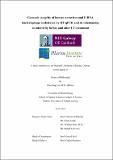| dc.contributor.advisor | Smith, Cindy | |
| dc.contributor.advisor | Doré, William | |
| dc.contributor.advisor | Keaveney, Sinéad | |
| dc.contributor.author | Lee, Chui Sang | |
| dc.date.accessioned | 2018-05-10T15:35:55Z | |
| dc.date.issued | 2018-05-10 | |
| dc.identifier.uri | http://hdl.handle.net/10379/7346 | |
| dc.description.abstract | A long-range RT (loRT) qPCR assay described to estimate levels of infectious virus was identified in the literature and applied to human norovirus (HuNoV) genogroups I and II (GI and GII), and the surrogate virus F-RNA bacteriophage genogroup II (GA) before/after UV-treatment. qPCR assays were performed in parallel to the GA plaque infectivity assay to confirm levels of infectious virus in samples. In UV-treated virus-spiked water and wastewater, virus genome copies detected using loRT were significantly less than those detected using the current established short-range (sRT) qPCR methods and demonstrated its potential to estimate virus infectivity.
sRT/loRT-qPCR was expanded into a multi-target assay and showed that loRT at the 5′ region of the genome better resembled levels of infectious virus than qPCR targets located at the middle and 3′ regions for GA. However, qPCR signal was observed in primer-independent RT reactions and was understood to be a universal emerging issue with the RT procedure, one that is severely under-reported in the literature. This study highlights how the choice of qPCR and RT target sites can influence the detection and quantification of target nucleic acids, how qPCR is consequently interpreted by the user and the importance of incorporating appropriate controls in both the RT and qPCR stages. | en_IE |
| dc.publisher | NUI Galway | |
| dc.rights | Attribution-NonCommercial-NoDerivs 3.0 Ireland | |
| dc.rights.uri | https://creativecommons.org/licenses/by-nc-nd/3.0/ie/ | |
| dc.subject | F-RNA bacteriophage | en_IE |
| dc.subject | human norovirus | en_IE |
| dc.subject | infectivity | en_IE |
| dc.subject | methodology | en_IE |
| dc.subject | reverse transcription (RT) | en_IE |
| dc.subject | primer-independent reverse transcription | en_IE |
| dc.subject | real-time quantitative polymerase chain reaction (qPCR) | en_IE |
| dc.subject | ultraviolet (UV) | en_IE |
| dc.subject | Microbiology | en_IE |
| dc.subject | Natural sciences | en_IE |
| dc.title | Genomic integrity of human norovirus and F-RNA bacteriophage as detected by RT-qPCR and its relationship to infectivity before and after UV-treatment | en_IE |
| dc.type | Thesis | en |
| dc.contributor.funder | Environmental Protection Agency | en_IE |
| dc.local.note | The current limitations of molecular methods for detecting and quantifying pathogens using RT-qPCR, a method based on the presence/absence of target nucleic acid, prevents us from distinguishing between infectious and non-infectious virus particles in a sample. This PhD aimed to develop and apply a novel long-range target RT-qPCR assay to virus samples before and after UV treatment to assess if genome integrity can be used as a proxy for virus infectivity. | en_IE |
| dc.description.embargo | 2021-05-09 | |
| dc.local.final | Yes | en_IE |
| nui.item.downloads | 59 | |


